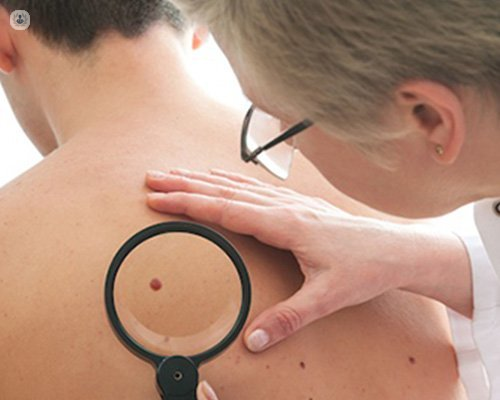What can I do to ensure I avoid developing skin cancer?
Autore:In this article below, Dr Marisa Taylor, a highly esteemed consultant dermatologist, speaks to us about skin cancer, including the warning signs and symptoms, the different types of skin cancer, and treatment options for patients with skin cancer.

What is skin cancer?
A cancer is an abnormal overgrowth of cells usually causing damage locally, and depending on the type of cancer, can spread to cause damage elsewhere in the body. The cancers which spread to other parts of the body are called malignant and those which tend not to spread are considered to be benign.
Skin cancer therefore, is an abnormal overgrowth of one or more of the cell types that make up the skin. The layers of the skin are: the epidermis on top that we see, the dermis below it, and below that is fat (the subcutaneous layer).
What are the warning signs and symptoms of skin cancer?
Signs and symptoms often depend on the type of skin cancer. The most common skin cancers start in the cells that make up epidermis as they get the most sun exposure. Skin cancers are categorised in two main groups: melanoma and non-melanoma skin cancers, probably because melanomas are highly malignant.
Let’s get some definitions straight first, starting with melanoma. A melanoma is a cancer of the cells called melanocytes. They make the pigment called melanin in our skin and send melanin in little packages to protect the nucleus in other skin cells by forming an umbrella over it.
The nucleus holds our DNA and, for example, excessive ultraviolet (UV) radiation can cause damage in the DNA that the cell cannot effectively repair. Some of the areas damaged in the DNA include signals that tell the cells when to stop growing and multiplying.
When this signal is disrupted, the affected skin cells replicate, which goes unchecked, causing a cancer. Some cancers, like melanomas, have a greater propensity to break away, evade our body’s natural policing mechanisms and travel via blood or lymphatic vessels to other areas in the body. The seeding of different areas of the body away from the original site of the cancer is called a metastasis.
Traditionally, signs of a melanoma include a new brown or black spot with an irregular shape and/or an uneven colour that possibly itches or bleeds. They can also arise in pre-existing moles that change in size, shape, colour and sensation.
Sometimes, melanoma cells do not and/or cannot make brown pigment, and instead are pink or red in colour. They may have a hint of brown colour within them. These are called amelanotic melanomas because they are not brown/black. Amelanotic melanomas are often picked up later as they are mistakenly considered to be benign.
Non-melanoma skin cancers, meanwhile, include the other types. The most common non-melanoma cancer is a basal cell carcinoma (BCC). These are cancers of the skin cells that make up the lowest/basal layer of the epidermis.
It largely affects lighter skin types, possibly because there are less and smaller melanin granules to form a protective umbrella over the basal nuclei. BCCs often present as a pink, pearly/shiny lump that may bleed on the face, ears, neck and trunk. Patients may remember getting a graze or having had some trauma that hadn’t healed. It can also present as a flat, scaly patch that easily traumatised.
Squamous cell cancer (SCC) is another common type of skin cancer. Like melanomas, SCCs can also metastasise (spread). These cancers arise in the upper cells of the epidermis, often in sun-exposed areas in lighter skinned individuals.
In darker skinned individuals, they tend to occur on a background of a long-standing wound such as a leg ulcer. In all skin types, certain strains of the human papillomavirus (HPV) can damage the squamous cells’ DNA-producing cancerous cells. HPV-related skin cancers often arise in the genital region.
What does skin cancer look like at the beginning?
Often, not very much in truth. If it’s a melanoma, it may just be an odd-looking mole. If it’s a basal cell carcinoma, it may be a non-healing wound. Squamous cell carcinoma usually starts as a scaly patch, or can be a small bump that rapidly grows. If you see anything unusual on your skin, get it checked out by a dermatologist.
Should I get checked out if I notice something strange on my skin?
Always. Early detection and treatment are essential.
How are skin cancers treated?
Skin cancer is treated by removing it completely. This is usually by surgical excision. However, depending on its stage, size, location and other patient factors, radiotherapy and chemotherapy are also offered on their own or alongside surgery. The surgery may be performed by your dermatologist or a specialist surgeon like a plastic surgeon. Your dermatologist will be able to discuss your options with you.
What can I do to ensure I avoid developing skin cancer?
You can do a lot of things to avoid skin cancer. The four main things you can do include:
- Avoid excessive sun exposure and sun bed use where possible - too much ultraviolet light exposure in fairer skin types is one of the main contributors to the three main types of skin cancer mentioned before.
- Practice sun safety - avoid the hottest times of day (11 am – 3 pm), wear adequate clothing and generously apply and re-apply of high factor broad spectrum screen. I would recommend Vitamin D supplementation as meticulous sun avoidance is likely to reduce Vitamin D production in the skin.
- Self-examine – get to know your skin and look out for new changes. Many of us have cameras on our phones, it is a good idea to monitor ourselves with images
- Have a healthy lifestyle – equip your body with the right nutrients, rest and pursuits.
However, it is important to note that none of us are the same and this advice must be tailored to each person. So, have a chat with your dermatologist to find out more.
If you would like to book an appointment with Dr Marisa Taylor today, you can do just that by visiting her Top Doctors profile today.



